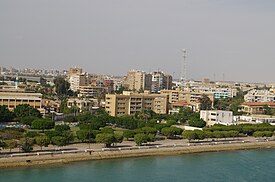Suez
السويس | |
|---|---|
 Satellite view of the port and city, the southern terminus of the Suez Canal that transits through Egypt and debouches into the Mediterranean Sea near Port Said. (Up is north-east). | |
| Coordinates: 29°58′N 32°33′E / 29.967°N 32.550°E | |
| Country | Egypt |
| Governorate | Suez |
| Founded | 1859 |
| Government | |
| • Governor | Abdel-mageed Saqr |
| Area | |
• Total | 9,002 km2 (3,476 sq mi) |
| Elevation | 11 m (36 ft) |
| Population (2021)[1] | |
• Total | 801,894 |
| • Density | 89/km2 (230/sq mi) |
| GDP | |
| • Total | EGP 119 billion (US$ 7.6 billion) |
| Time zone | UTC+3 (EGY) |
| Website | Suez.gov.eg |
Suez (/ˈsuː.ɛz/, Egyptian Arabic: السويس, romanized: as-Suways, pronounced [esseˈweːs]) is a seaport city (population of about 700,000 as of August 2021[update]) in north-eastern Egypt, located on the north coast of the Gulf of Suez on the Red Sea, near the southern terminus of the Suez Canal, and is the capital of the Suez Governorate. It has three ports: the Suez Port (Port Tewfik), al-Adabiya,[3] and al-Zaytiya,[4] and extensive port facilities. Together they form a metropolitan area, located mostly in Africa with a small portion in Asia.
29°58′N 32°33′E / 29.967°N 32.550°ERailway lines and highways connect the city with Cairo, Port Said, and Ismailia. Suez has a petrochemical plant, and its oil refineries have pipelines carrying the finished product to Cairo. These are represented in the flag of the governorate: the blue background refers to the sea, the gear refers to Suez's status as an industrial governorate, and the flame refers to the petroleum firms of Suez.
The modern city of Suez is a successor of the ancient city of Clysma, a major Red Sea port and a center of monasticism.[5]
- ^ a b c "Egypt: Governorates, Major Cities & Towns - Population Statistics, Maps, Charts, Weather and Web Information". www.citypopulation.de. Retrieved 18 March 2023.
- ^ "GDP BY GOVERNORATE", mped.gov.eg
- ^ "Al Adabiya port – SCZONE".
- ^ "الهيئة العامة لموانئ البحر الأحمر || الموقع الرسمي".
- ^ Mayerson, Philip (1996). "The Port of Clysma (Suez) in Transition from Roman to Arab Rule". Journal of Near Eastern Studies. 55 (2): 119–126. doi:10.1086/373802. JSTOR 546035. S2CID 163029985.







